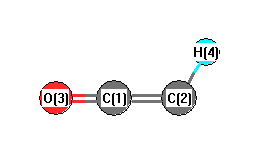Jump to
S1C2
Energy calculated at QCISD/daug-cc-pVDZ
| | hartrees |
|---|
| Energy at 0K | -151.546648 |
| Energy at 298.15K | |
| HF Energy | -151.103142 |
| Nuclear repulsion energy | 51.886499 |
The energy at 298.15K was derived from the energy at 0K
and an integrated heat capacity that used the calculated vibrational frequencies.
Vibrational Frequencies calculated at QCISD/daug-cc-pVDZ
| Mode Number |
Symmetry |
Frequency
(cm-1) |
Scaled Frequency
(cm-1) |
IR Intensities
(km mol-1) |
Raman Act
(Å4/u) |
Dep P |
Dep U |
|---|
| 1 |
Σ |
3452 |
3452 |
117.64 |
|
|
|
| 2 |
Σ |
2072 |
2072 |
236.05 |
|
|
|
| 3 |
Σ |
1281 |
1281 |
21.46 |
|
|
|
| 4 |
Π |
553 |
553 |
1.29 |
|
|
|
| 4 |
Π |
507 |
507 |
2.32 |
|
|
|
| 5 |
Π |
232 |
232 |
29.57 |
|
|
|
| 5 |
Π |
489i |
489i |
110.06 |
|
|
|
Unscaled Zero Point Vibrational Energy (zpe) 3804.0 cm
-1
Scaled (by 1) Zero Point Vibrational Energy (zpe) 3804.0 cm
-1
See section
III.C.1 List or set vibrational scaling factors
to change the scale factors used here.
See section
III.C.2
Calculate a vibrational scaling factor for a given set of molecules
to determine the least squares best scaling factor.
Geometric Data calculated at QCISD/daug-cc-pVDZ
Point Group is C∞v
Cartesians (Å)
| Atom |
x (Å) |
y (Å) |
z (Å) |
|---|
| C1 |
0.000 |
0.000 |
0.022 |
| C2 |
0.000 |
0.000 |
-1.257 |
| O3 |
0.000 |
0.000 |
1.218 |
| H4 |
0.000 |
0.000 |
-2.331 |
Atom - Atom Distances (Å)
| |
C1 |
C2 |
O3 |
H4 |
| C1 | | 1.2791 | 1.1963 | 2.3528 |
C2 | 1.2791 | | 2.4754 | 1.0737 | O3 | 1.1963 | 2.4754 | | 3.5491 | H4 | 2.3528 | 1.0737 | 3.5491 | |
 More geometry information
More geometry information
Calculated Bond Angles
| atom1 |
atom2 |
atom3 |
angle |
|
atom1 |
atom2 |
atom3 |
angle |
| C1 |
C2 |
H4 |
180.000 |
|
C2 |
C1 |
O3 |
180.000 |
Electronic energy levels
Charges, Dipole, Quadrupole and Polarizability
Jump to
S1C1
Energy calculated at QCISD/daug-cc-pVDZ
| | hartrees |
|---|
| Energy at 0K | -151.551488 |
| Energy at 298.15K | |
| HF Energy | -151.103623 |
| Nuclear repulsion energy | 51.693543 |
The energy at 298.15K was derived from the energy at 0K
and an integrated heat capacity that used the calculated vibrational frequencies.
Vibrational Frequencies calculated at QCISD/daug-cc-pVDZ
| Mode Number |
Symmetry |
Frequency
(cm-1) |
Scaled Frequency
(cm-1) |
IR Intensities
(km mol-1) |
Raman Act
(Å4/u) |
Dep P |
Dep U |
|---|
| 1 |
A' |
3306 |
3306 |
22.27 |
|
|
|
| 2 |
A' |
2042 |
2042 |
378.46 |
|
|
|
| 3 |
A' |
1204 |
1204 |
3.83 |
|
|
|
| 4 |
A' |
607 |
607 |
148.49 |
|
|
|
| 5 |
A' |
509 |
509 |
126.32 |
|
|
|
| 6 |
A" |
486 |
486 |
1.86 |
|
|
|
Unscaled Zero Point Vibrational Energy (zpe) 4076.3 cm
-1
Scaled (by 1) Zero Point Vibrational Energy (zpe) 4076.3 cm
-1
See section
III.C.1 List or set vibrational scaling factors
to change the scale factors used here.
See section
III.C.2
Calculate a vibrational scaling factor for a given set of molecules
to determine the least squares best scaling factor.
Geometric Data calculated at QCISD/daug-cc-pVDZ
Point Group is Cs
Cartesians (Å)
| Atom |
x (Å) |
y (Å) |
z (Å) |
|---|
| C1 |
0.000 |
0.063 |
0.000 |
| C2 |
1.104 |
-0.675 |
0.000 |
| O3 |
-1.096 |
0.502 |
0.000 |
| H4 |
2.140 |
-0.343 |
0.000 |
Atom - Atom Distances (Å)
| |
C1 |
C2 |
O3 |
H4 |
| C1 | | 1.3280 | 1.1801 | 2.1784 |
C2 | 1.3280 | | 2.4945 | 1.0881 | O3 | 1.1801 | 2.4945 | | 3.3442 | H4 | 2.1784 | 1.0881 | 3.3442 | |
 More geometry information
More geometry information
Calculated Bond Angles
| atom1 |
atom2 |
atom3 |
angle |
|
atom1 |
atom2 |
atom3 |
angle |
| C1 |
C2 |
H4 |
128.472 |
|
C2 |
C1 |
O3 |
168.054 |
Electronic energy levels
Charges, Dipole, Quadrupole and Polarizability
